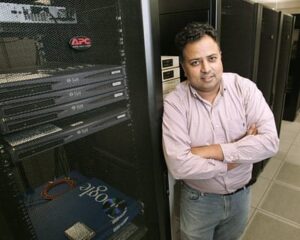Big data needs big power.
The server farms that undergird the Internet run on a vast tide of electricity. Even companies that have invested in upgrades to minimize their eco-footprint use tremendous amounts: The New York Times estimates that Google, for example, uses enough electricity in its data centers to power about 200,000 homes.
Now, a team of Princeton University engineers has a solution that could radically cut that power use. Through a new software technique, researchers from the School of Engineering and Applied Science have opened the door for companies to use a new type of memory in their servers that demands far less energy than the current systems.
The software, called SSDAlloc, allows the companies to substitute solid state memory, commonly called flash memory, for the more expensive and energy-intensive type of memory that is now used for most computer operations.
“The biggest potential users are the big data centers,” said Vivek Pai, an associate professor of computer science who developed the program with graduate student Anirudh Badam. “They are going to see the greatest improvements.”
A version of SSDAlloc is already being used with high-end flash memory manufactured by Fusion-io, of Salt Lake City. Princeton has signed a non-exclusive licensing agreement with the company. Brent Compton, Fusion-io’s senior director of product management, said the software “simplifies performance for developers in ways that were out of reach just a couple of years ago.”
The massive server centers that support operations ranging from online shopping to social media are built around a type of computer memory called random access memory, or RAM. While very fast and flexible, RAM needs a constant stream of electricity to operate.
The power not only costs money, it also generates heat that forces the companies to spend more funds on cooling.
The Princeton engineers’ program allows the data companies to substitute flash memory — similar to chips used in “thumb drives” — for much of their RAM. Unlike RAM, flash only uses small amounts of electricity, so switching memory types can drastically cut a company’s power bill. In extreme cases, depending on the type of programs run by the servers, that reduction can be as much as 90 percent (compared to a computer using RAM alone). And because those machines are not generating as much heat, the data centers can also cut their cooling bills.
Flash memory is also about 10 times cheaper than RAM, so companies can also save money on hardware upfront, Pai said.
via Princeton University
The Latest Streaming News: data center energy conservation updated minute-by-minute









